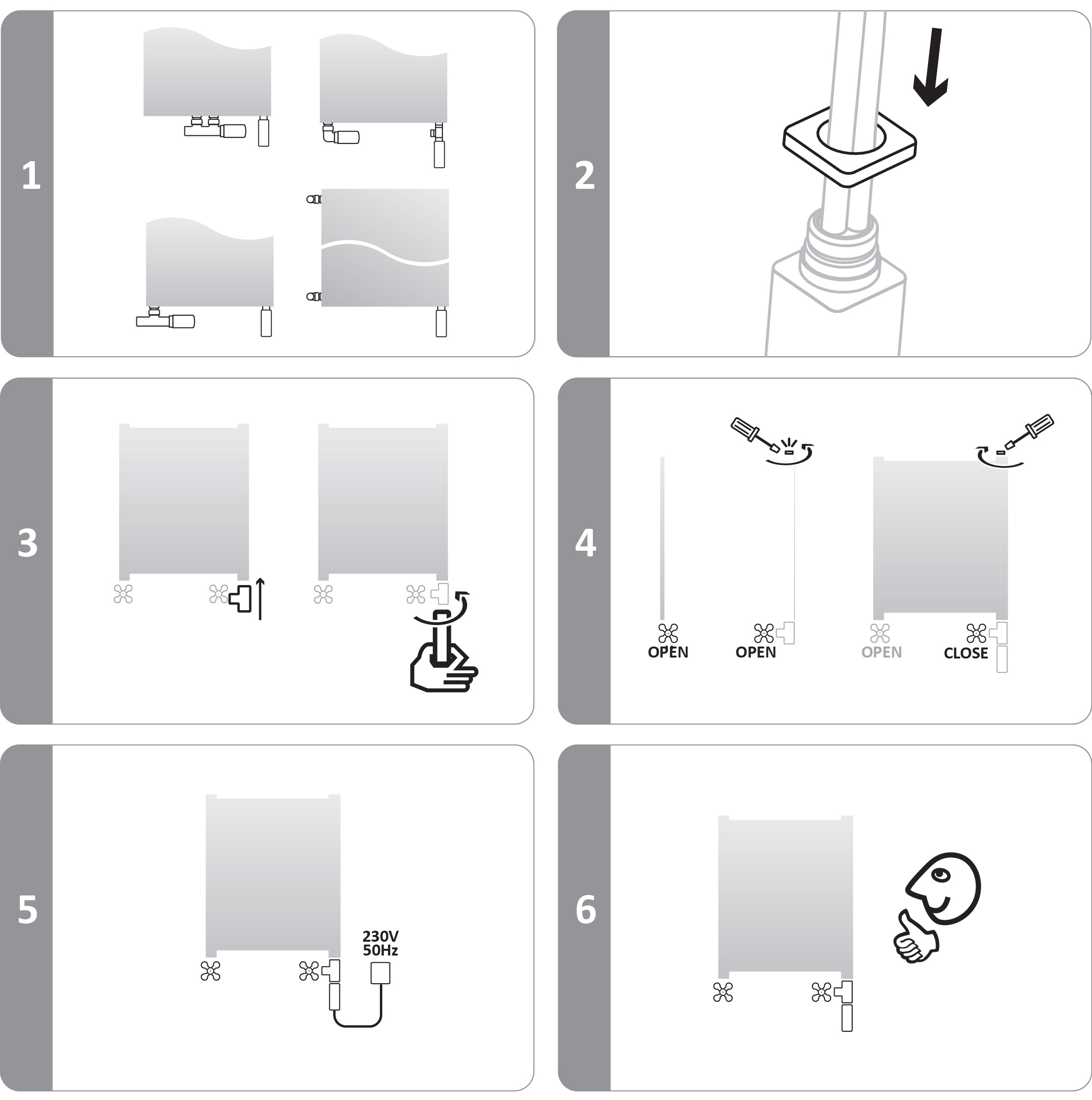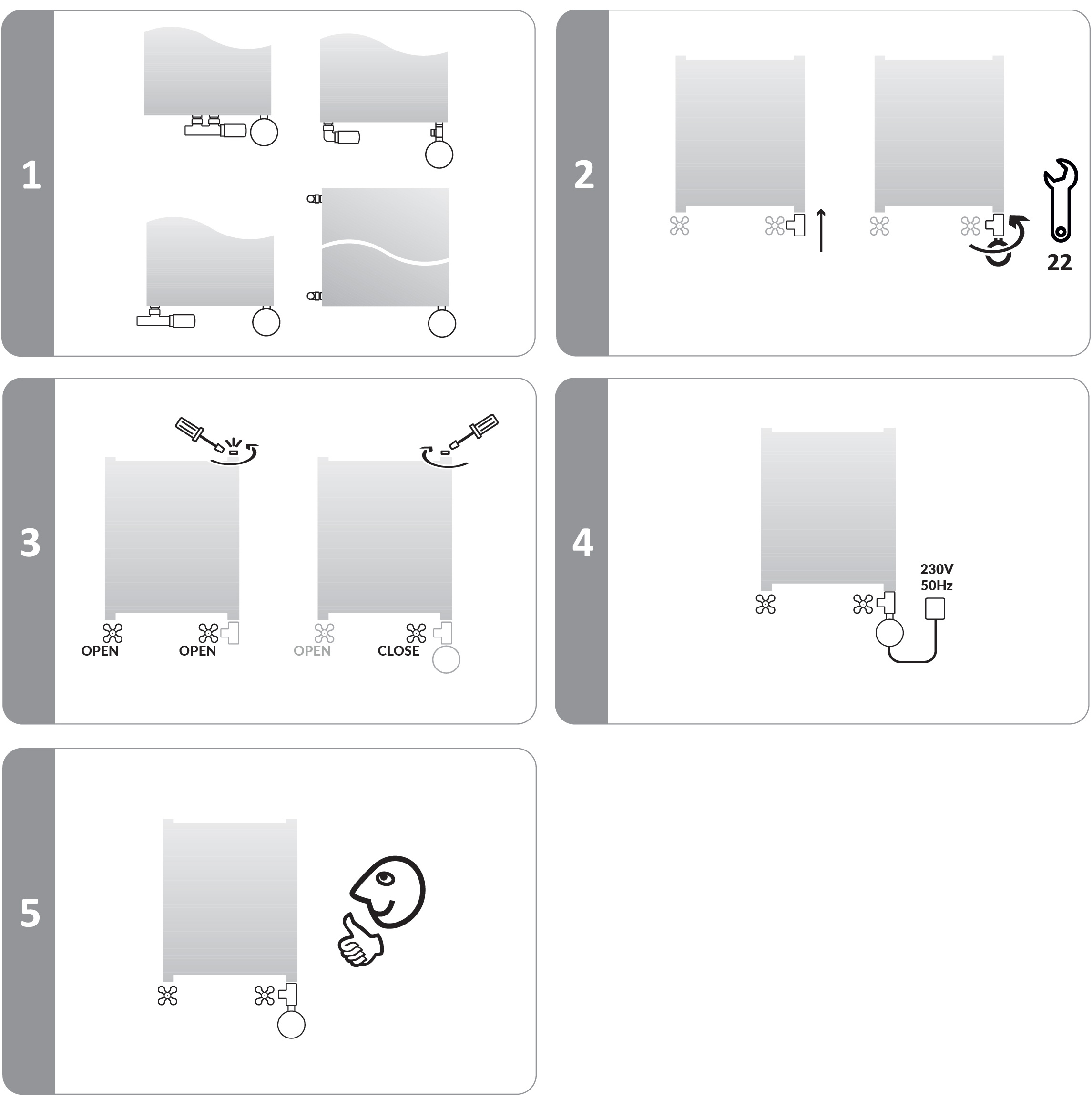Why is the radiator bubbling?
Overflowing and bubbling water are the noises most frequently complained about by users of radiators that are connected to a system that has been aerated. This means that there is gas in the installation pipes, and consequently also in the radiators, which adversely affects the circulation of the heating medium. Most often, to eliminate the problem it is sufficient to bleed the radiator.
How to fit a One heating element for my radiator?
To assist you with identifying which type of One heating element is suitable for your selected radiator model, please refer to the TIPS tab here.
This section lists the full cross-section of the One heating elements and provides the compatibility for particular radiator designs , and additional electric cable masking options.
How to instal an electric heating element in a radiator?
The ONE heating element installed in a dual fuel radiator

1. Choose the option of installation that fits to you best. 2. Slide on masking cover. 3. Fit the T-fitting to the radiator (if needed) and then install the heating element. Install and tighten by hand only. 4. Fill the radiator with the water, then bleed it. Once bled make sure that at least one valve re- mains open. NEVER OPERATE THE HEATING ELEMENT WITH BOTH VALVES CLOSED. 5. Connect the heating element to the power supply. 6. Your radiator is ready.
HINT: Do not turn on the heating element and your central heating at the same time.
The ONE heating element installed in an electric only radiator

1. Correct position of the radiator and heating element. 2. Slide on masking cover. 3. Install and tighten the heating element by hand only. 4. Fill the radiator with a proper heating agent. 5. Fit the radiator to the wall and connect the heating element to the power supply. 6. Set the heater on max and keep it for 30min (the plug opening must be open). 7. Check the level of the hot heating agent inside the radiator, add more if needed. 8. Close the radiator plug. Your radiator is ready.
The MEG/MOA/SOA/SEC/REG heating element installed in a dual fuel radiator

1. Choose the option of installation that fits to you best. 2. Fit the T-fitting to the radiator (if needed) and then install the heating element. Tighten it using the correct spanner (size 22). 3. Fill the radiator with the water, then bleed it. Once bled make sure that at least one valve re- mains open. NEVER OPERATE THE HEATING ELEMENT WITH BOTH VALVES CLOSED. 4. Connect the heating element to the power supply. 5. Your radiator is ready.
HINT: Do not turn on the heating element and your central heating at the same time.
The MEG/MOA/SOA/SEC/REG heating element installed in an electric only radiator

1. Correct position of the radiator and heating element. 2. Install and tighten the heating element using the correct spanner (size 22). 3. Fill the radiator with a proper heating agent. 4. Fit the radiator to the wall and connect the heating element to the power supply. 5. Set the heater on max and keep it for 30min (the plug opening must be open). 6. Check the level of the hot heating agent inside the radiator, add more if needed. 7. Close the radiator plug.
Your radiator is ready.
Why are the bottom pipes of an electric radiator cool?
The distribution of heat in an electric radiator is the result of particle diffusion within the heating medium and heating medium circulation. As a result of both of these processes hot liquid particles mix with cool particles and distribute heat across the radiator.
The collector in which the heating element is installed is the hottest part of the radiator and the pipes in the lower part of the radiator usually remain cool. This is expected behaviour.
The cool pipes at the bottom are a result of the 7 cm so called dead (not heated up) zone in the heating element. The dead zone allows safe operation of a heating element installed through a T-piece in a radiator connected to a central heating installation. When the heating element is connected through a T-piece the dead zone covers the length of the T-piece, however, when the heating element is installed directly in the radiator, the zone moves upward resulting in the lower temperature of one or two lower pipes. In addition, in narrow and high radiators the upper part can also remain cooler due to the air cushion (protection against excessive pressure rise), in particular at lower temperature settings and while the radiator is warming up.
Can I hang damp clothes on a chrome-plated radiator?
Chrome coating is not airtight. Naturally occurring micro-pores cause penetration of the chrome layer. While water is not a major threat, other chemicals, especially chlorine, and other substances found in washing powders and fabric dyes may react causing micro-cracks, delamination, fading, and ultimately even corrosion of the radiator.
Terma applies solutions that protect chrome radiators against the danger of corrosion, cracks and discoloration in accordance with the highest and most advanced world standards. Two protective layers are applied on each radiator before chrome plating.
The first one – the copper layer, is very tight. It provides adequate adhesion and constitutes ideal corrosion protection. Copper forms a stable 20 microns layer. It repairs any steel surface inadequacies in a gentle and permanent way, which ensures a very smooth surface for the application of subsequent layers.
The second layer – the nickel one, is a primer for the application of chrome coating and provides additional corrosion protection. Copper and nickel coatings are tight, but characterized by low mechanical resistance. Therefore, we apply the third, chromium layer, which lightens up details and changes colour from delicate shade of brown to pure silver. Additionally, chrome coating is highly resistant to mechanical damage. Chromium is resistant to neutral agents, so a damp towel will not affect the aesthetic value of the heater. However, if the same towel is soaked with an active agent the risk of discoloration or other damage appears. To keep a chrome-plated radiator in an ideal condition for a much longer period of time than is guaranteed by Terma, please adhere to the following guidelines. Firstly, under no circumstances clean the surface of chrome-plated radiators with products containing chlorine in any form. Secondly, do not use abrasive cleaners.
How to prevent radiator corrossion?
The most important thing is to prevent paint coating damages and to use the radiator in accordance with the manual. One must observe the operating parameters specified in the product specifications. This applies in particular to the working pressure, because excessive pressure can destroy the radiator. Make sure to use the heating medium of proper quality. Wrong pH value or oxygen saturation can cause radiator corrosion. When installing a radiator in a bathroom follow the safety guidelines listed in the manual – the radiator must not be installed too close to a sink or shower. Frequent exposure to splashes of water can cause gradual damage of the paint coating. After the heating season the heating medium must not be removed from the radiator.
How to take care of your radiator?
The most important thing is to prevent paint coating damages and to use the radiator in accordance with the manual. If the radiator is equipped with a heating element one must observe the basic safety rules, e.g. avoid splashing any liquids on the electric device. Besides one must not put loads exceeding 5 kg on the radiator or apply a comparable force against it. One must also observe the operating parameters specified in the product specifications. This applies in particular to the working pressure, because excessive pressure can destroy the radiator. Make sure to use the heating medium of proper quality. Wrong pH value or oxygen saturation can cause radiator corrosion. Connecting the radiator to the domestic hot water system or refilling the installation with liquids having unsuitable chemical properties can also bring about radiator damage. The heating medium temperature must not fall below 0 °C. The radiator can be cleaned with domestic cleaning products except for those containing solvents or abrasives. Applying any additional layers of paint or lacquer to the radiator is not allowed. Any changes in the construction of the radiator and/or warranty repairs can only be conducted by the Manufacturer. Terma provides 8-year warranty on the radiator coating in all RAL and special colors and 8 years for water tightness of the radiators.


